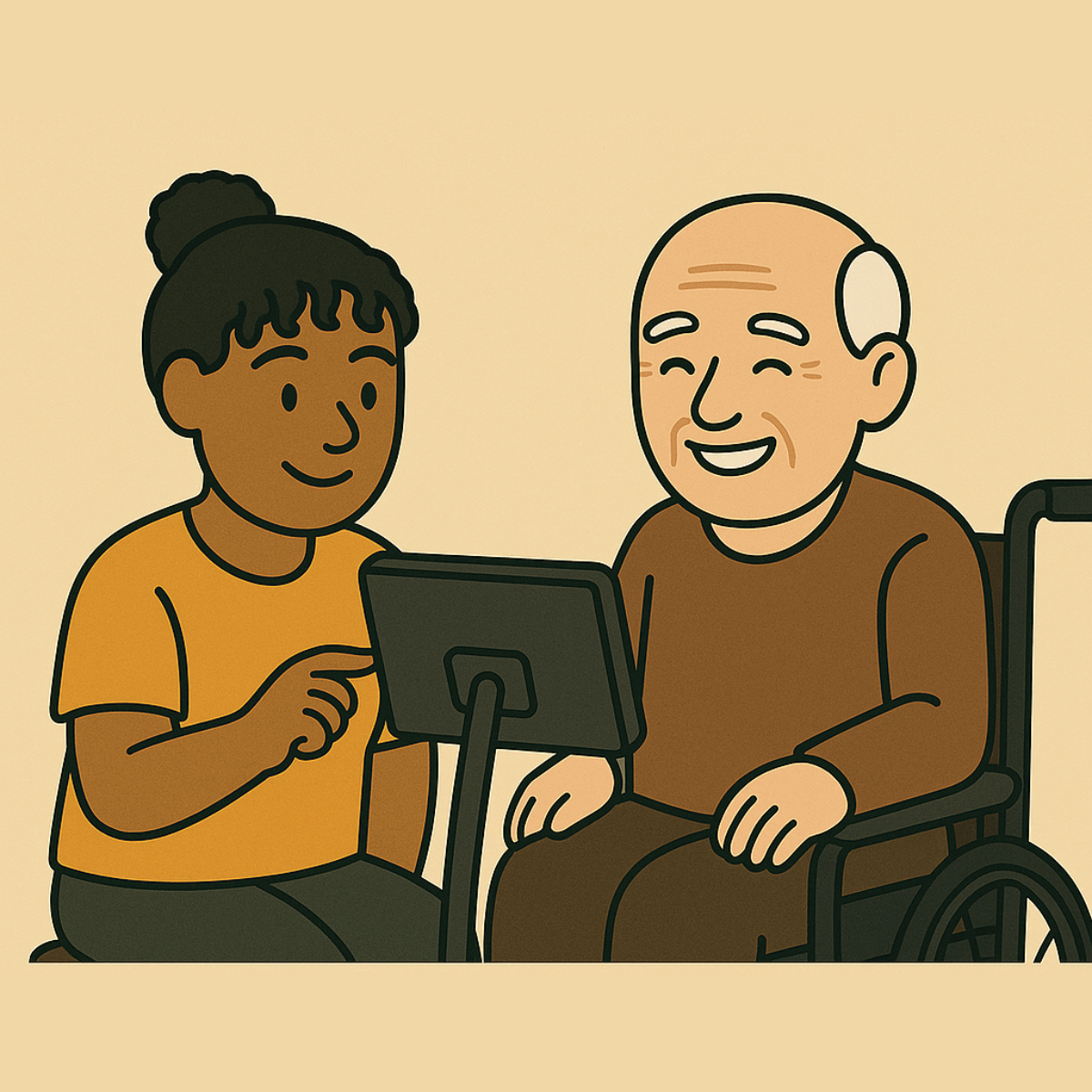7-minute read
This post contains affiliate links. If you purchase through these links, I may earn a small commission—at no extra cost to you. I only recommend tools I believe are helpful and relevant for patients, therapists, and caregivers.
Introduction: When Words Become a Lifeline
Losing the ability to speak is one of the most painful changes that can come with ALS. But communication doesn’t have to stop there—and it shouldn’t. For people living with ALS, being able to express themselves means holding onto their voice, their choices, and their identity.
As a rehab therapist, I’ve seen firsthand how the right support can open doors to connection, even as speech becomes more difficult. Whether you’re a caregiver, therapist, or loved one, these six communication tips can help you support someone with ALS in ways that are both practical and deeply meaningful.
Fast Facts About ALS

Before we jump into the tools and strategies, let’s cover the basics:
- What is ALS?
ALS (amyotrophic lateral sclerosis) is a progressive neurodegenerative disease that affects nerve cells in the brain and spinal cord. It weakens voluntary muscles, including those needed for talking, eating, and moving. - Who gets ALS?
Most people are diagnosed between ages 40 and 70, with the average age around 55. It’s rare, but can also affect younger or older individuals. - Is ALS always genetic?
No. About 90–95% of cases are sporadic, meaning no known family history. - Does ALS affect the mind?
In most cases, cognition is preserved—even as speech and mobility decline. - Does everyone with ALS lose their voice?
Many do over time, especially with bulbar-onset ALS. But with tools and planning, communication can continue in different forms.
Source: CDC ALS Facts
Stages of ALS and Communication Changes
Understanding where someone is in the ALS journey can help tailor communication support. Here’s a simplified breakdown:
| Stage | Common Signs | Communication Support |
| Early | Mild slurring, some limb weakness | Writing tools, letter boards, voice banking |
| Middle | Noticeable speech and hand weakness | AAC devices, voice amplifiers |
| Late | Severe speech and mobility loss | Eye gaze systems, pre-programmed AAC tools |
1. Start Simple: Use Writing Tools and Communication Boards

In the early stages, speech may be slurred or tiring, but hand control is usually still intact. That makes low-tech tools like:
a great place to start.
Why it helps: These tools are quick, reliable, and allow people to express needs without complicated setup.
Recommended Products:
2. Make Their Voice Louder: Try a Voice Amplifier

If someone’s voice becomes soft but still functional, a portable voice amplifier can help. It’s especially useful during family gatherings or doctor visits.
Recommended Product:
Therapist Tip: Test out different microphone positions and volumes to prevent feedback and make conversations easier for everyone.
3. Use AAC Devices for Ongoing Communication

As ALS progresses, speech may become hard to understand—or disappear completely. That’s when AAC (Augmentative and Alternative Communication) steps in.
AAC devices can include:
- Tablets with speech apps
- Single-message buttons
- Text-to-speech scanner
Recommended Products:
- Ablenet BIGmack Communicator
- Jelly Bean Switch (for hands-free control)
Need to Know: These tools work best when set up before communication becomes too limited. An SLP (speech-language pathologist) can guide the process.
4. Go Hands-Free: Try Eye-Gaze or Head-Control Technology

When hand movement is no longer possible, tech doesn’t give up—it adapts.
Eye-gaze systems and head-controlled mice let users move a cursor with their eyes or head and click to speak, type, or control their environment.
Recommended Product (Head-controlled alternative):
These systems can take some setup and training, but once in place, they empower full communication—even in advanced stages.
5. Keep Using Devices with Adaptive Styluses

If a person can’t use their fingers but still has some upper body or head movement, adaptive styluses can help them use tablets and phones.
Options include:
- Mouth stick styluses
- Head-mounted or hand-mounted styluses
- No-touch capacitive styluses
Recommended Products:
6. Plan Ahead with Voice Banking

One of the most meaningful things a person with ALS can do early on is record their voice before it’s lost. This is called voice banking—and the recorded clips can later be used in speech-generating devices.
Recommended Resources:
This process lets them speak with their own voice, even when their body can’t.
Conclusion: Your Voice Is Still Yours
ALS takes away many things—but with planning, creativity, and care, communication doesn’t have to be one of them. Every person deserves to express who they are, what they want, and how they feel. Whether it’s a simple letter board or an eye-controlled tablet, there are always ways to stay connected.

Download Your Free Rehab Therapy Quick Reference Sheets
Grab our printable OT, PT, and ST cheat sheets—great for clinics, home visits, and caregivers!
Need More Tools? Our Rehab Therapy Pocket Guides Are Here to Help

- OT Pocket Guide – OUT NOW!
- ST Pocket Guide – Coming This May
- PT Pocket Guide – Coming This October
Each guide is packed with checklists, tips, and real-world tools for therapists and caregivers.


Leave a Reply